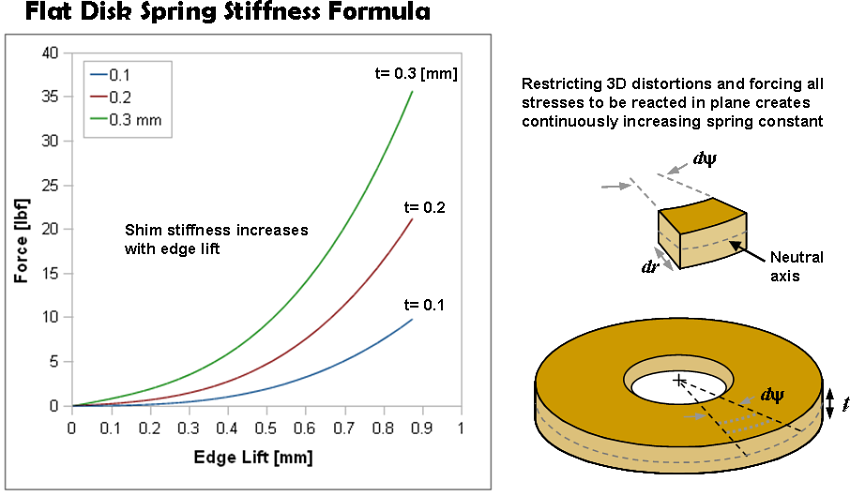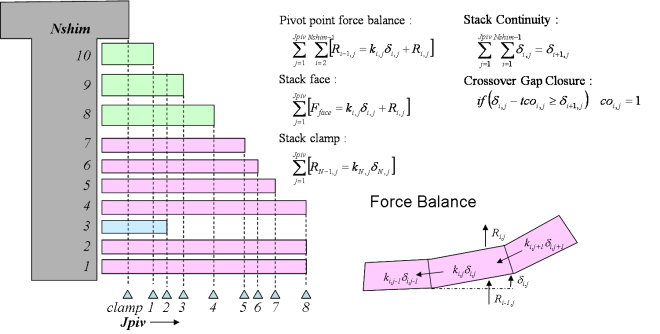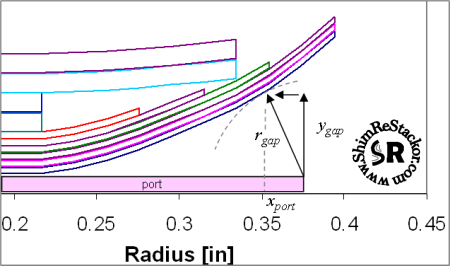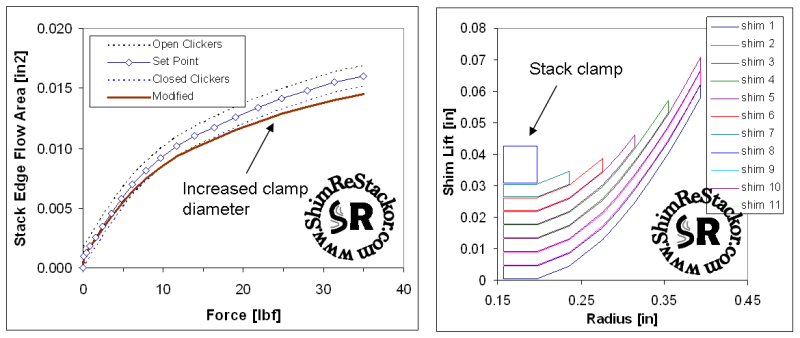

Stack Stiffness

Shim Stack Stiffness
Evaluating effects of shim stack stiffness on shock absorber performance requires calculation of three basic components:
-
The stiffness of each individual shim
-
The stiffness of the shim stack structure accounting for effects of crossover gaps, stack taper and the stack clamp shim diameter
-
The fluid flow area at the valve face as the shim stack progressively deflects at higher applied forces
ReStackor models each of those components using physics based relationships developed through years of technology development in structural analysis and the practical experience of spring manufactures. Coupling shim stiffness calculations with thorough FEA analysis of the shim stack structure allows complex shim stack configurations to be reliably computed accounting for effects of multiple crossover gaps, stack taper, shim thickness variations in the stack and the effect of backer shims to limit the stack travel.
The physics based analysis used to evaluate each of those components are discussed in the frames below.
![]()
ReStackor uses physics based relationships to accurately compute shim stiffness
ReStackor integrates Hooke's law and Young's modulus of elasticity through the curvilinear coordinates of a shim to determine the internal stresses created when the shim is bent. Those same physics based stress integrations are used in the design of leaf springs and coil springs. The relationships are well known and well anchored through years of industrial spring development and manufacturing technology. Within the limits of material property definitions spring design equations are exact (more).

![]()
Detailed force balance used to accurately compute stack stiffness and interactions of design features within the stack structure
A central feature of ReStackor is the capability to compute a detailed stack structure force balance, accurately account for stack edge lift and complex shim stack structures used in practical shock absorbers. The ReStackor force balance includes effects of shim thickness, stack taper, clamp diameter, crossover shims, backing shims and the interactions of those features as the stack structure changes with edge lift. A stack of 50 shims requires ReStackor to solve 4950 simultaneous equations to determine force transfer through the shim stack structure (more) .

ReStackor shim stack force balance solves 5,000 simultaneous equations to determine the stack stiffness.
![]()
Flow Area At The Shim Stack Face
Calculation of the deflection of the stack structure alone is inadequate to evaluate shock absorbers performance. To compute damping performance the fluid flow area and resistance through the deflected shim stack structure must be evaluated. The flow area is a function of the valve port geometry and bend profile of the stack face shim. ReStackor integrates the fluid flow area along the edge and side of the valve port to determine flow area and accurately account for the bend profile of the stack face shim (more) .

ReStackor accounts for effects of face shim bend profiles in evaluation of fluid flow area available at the valve face.
FEA based analysis can accurately determine deflection of complex shim stack structures as demonstrated in the literature. Proof of that comes through comparison of shock absorber dyno data over a range of shim stack structures.
![]()
Shim Stack Stiffness Tuning
The baseline Shim ReStackor code allows you to compute the stiffness of your current shim stack and compare potential stack modifications in terms of you many "clicks" stiffer or softer the modified stack will be. In the example below the stack clamp diameter was increased. The larger clamp produces high speed damping rates equivalent to riding your current stack with the clickers fully closed. If that change is beyond what you intended the you know you need to work on the stack taper, not the clamp diameter.
Shim ReStackor references shim stack changes in terms of clicker settings allowing you to easily interpret the effect of each change to the shim stack.
The capability of Shim ReStackor to reference stack stiffness to clicker changes saves a huge amount of time setting up a suspension. Referencing stack changes to clicker settings allows you to use your real world riding experience to evaluate shim stacks and search for shim changes that provide two clicks stiffer high speed or add a crossover shim to provide three click softer low speed while maintaining the same high speed. Tuning in software also allows you to test hundreds of stack configurations to find the best combination of face shims and stack taper to get the stiffness you want. Referencing potential shim stack changes to clicker settings in ReStackor helps to eliminate stacks that are "way outside the box" and wasting time testing shim stacks that are way too stiff or way too soft.

